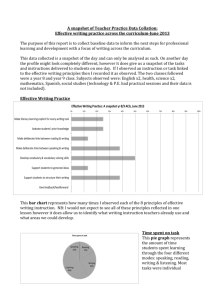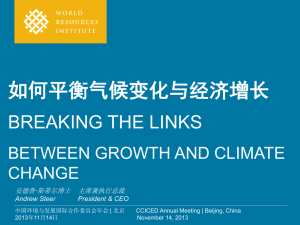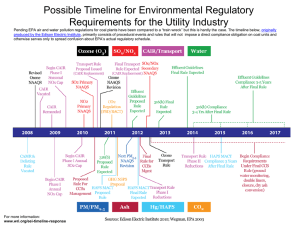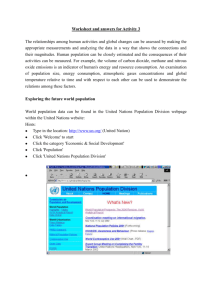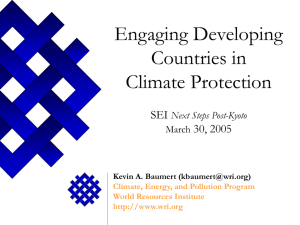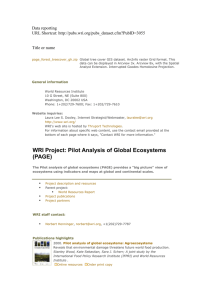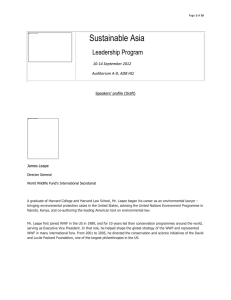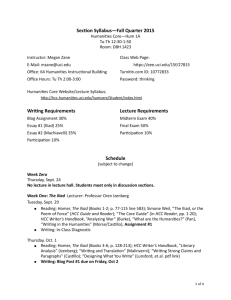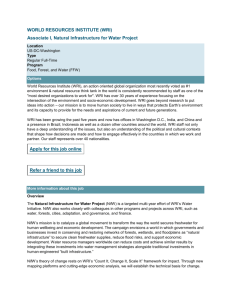WRI - Center for Climate and Energy Solutions
advertisement
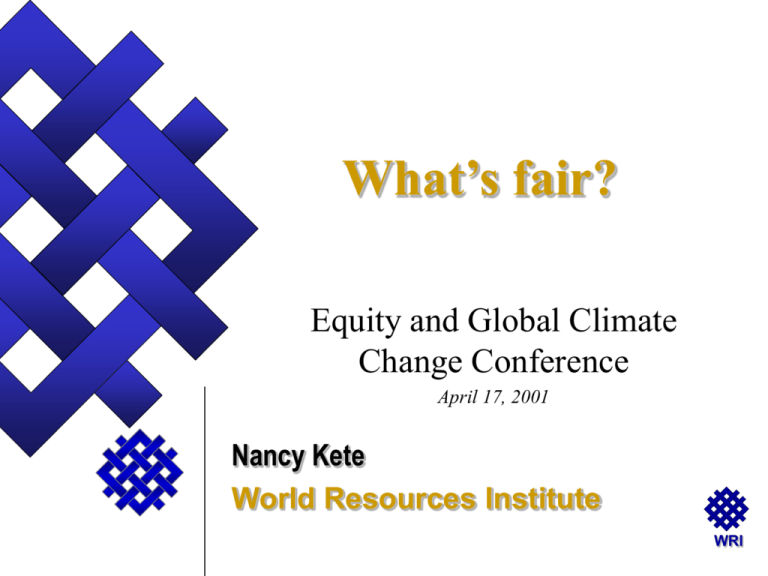
What’s fair? Equity and Global Climate Change Conference April 17, 2001 Nancy Kete World Resources Institute WRI Here’s one view “The United States Senate would not ratify any protocol, any treaty that did not …include all nations of the world under the same kind of mandatory, legally binding conditions as Europe or the United States.” – U.S. Senator Chuck Hagel, “Big Shot” interview on Tech Central Station 11/13/00 WRI Here’s another “The right to emit carbon dioxide is a human right that should be allocated on an equal basis to all of humankind.” Aubrey Meyer, Contraction and Convergence: The global solution to climate change WRI And a third “It is obvious that in the future the world will have to accept some common maximum per capita emission for each country in order to deal with global warming.” Anil Agarwal and Sunita Narain, in The atmospheric rights of all people on earth, CSE website www.oneworld.org WRI “For every complex problem, there is a solution that is simple, neat, and wrong.” H.L. Mencken WRI Beware of moral certitude These claims all have a ring of moral certitude that doesn’t withstand scrutiny. WRI Beware of moral certitude • The Byrd-Hagel resolution seems mainly aimed at ensuring no progress -- it’s a smokescreen. • The per capita rights talk seems mainly aimed at redistributing global wealth and is fraught with ethical and practical difficulties. • Both are inconsistent with FCCC provisions on equity. WRI What is fair? • Solutions that are consistent with FCCC provisions -- complex, multi-faceted, qualitative. • Beyond this, it is not at all obvious what constitutes a fair response to climate change WRI The climate convention on equity • 3.1. equity, common but differentiated responsibilities, North takes the lead. • 3.2. & 3.4 consider specific needs, circumstances, conditions of all Parties, especially developing countries • 3.3. policies and measures should “ensure global benefits at the lowest possible costs” • 4.7. developing country commitments are conditional upon successful developed country implementation of commitments related to financial resources and technology transfer WRI Formulas won’t work Emissions Population Wealth Etc. = Equity? “Equity as a legal concept is a direct emanation of the idea of justice.” (International Court of Justice, 1982, case concerning the continental shelf ) Equitable cannot be reduced to egalitarian. WRI The moral ambiguities of fairness • Many theories of what is just, fair, or equitable – – – – Utilitarianism: nations equally “share burdens” Maximin: give entitlements to the poor countries Entitlement theories: build on the status quo Egalitarianism: equal share to nations or persons • Which theory of justice one adopts or applies depends on: – what information one has – and one’s own circumstances • Most theories of fairness apply to individuals, not countries WRI Scrap the rights talk • Talk of rights and entitlements focuses unduly on: – Allocating atmospheric rights (dividing the pie) – Trading of atmospheric rights • Emission rights will be balanced by demanding obligations: – – – – binding targets and non-compliance consequences sound measurement and reporting third party verification systems transparent registries and accounting systems • For many countries, these are excessively hard WRI The atmosphere is not divisible • No one can, or does, own the atmosphere • Atmospheric use rights are or ought to be: – collectively managed by the COP for the purposes of meeting UNFCCC’s safe climate objective – time-bound and subject to review and revision – conditional (upon undertaking specific obligations) • Lessons from the U.S. Clean Air Act Amendments: an allowance is defined as limited authorization to emit SO2 in accordance with provisions of the law. Allowances are not property rights. WRI Avoid one-size-fits-all ideas • The treaty will need: – different levels of participation for different countries – mechanisms and policy tools that can enable more equitable outcomes (e.g., carbon intensity) WRI Carbon Intensity • Not a global planning principle; not a convergence criterion; doesn’t deliver equity • It is a way to think about how countries can reduce emissions WRI Carbon Intensity • For developing countries, it could provide a way to make new, formal commitments, while avoiding environmental and economic risks associated with emissions caps. • Carbon intensity can also be an indicator of progress for countries not ready to commit. WRI Carbon intensity focuses on energy and fuels Well known identity: CO2 Emissions = GDP X Population X Energy per person GDP “Activity” levels (GDP p/c and Population) X CO2 Energy Energy Intensity Fuel Mix of Economy WRI Carbon intensity focuses on energy and fuels Carbon intensity: measures mainly energy intensity and the fuel mix, not economic activity CO2 = GDP Energy GDP X CO2 Energy Energy Intensity Fuel Mix of Economy WRI Carbon Intensity • Can broaden participation without insisting all countries take binding emissions caps • It avoids the categorical error that the atmosphere can be divided among all living persons WRI
